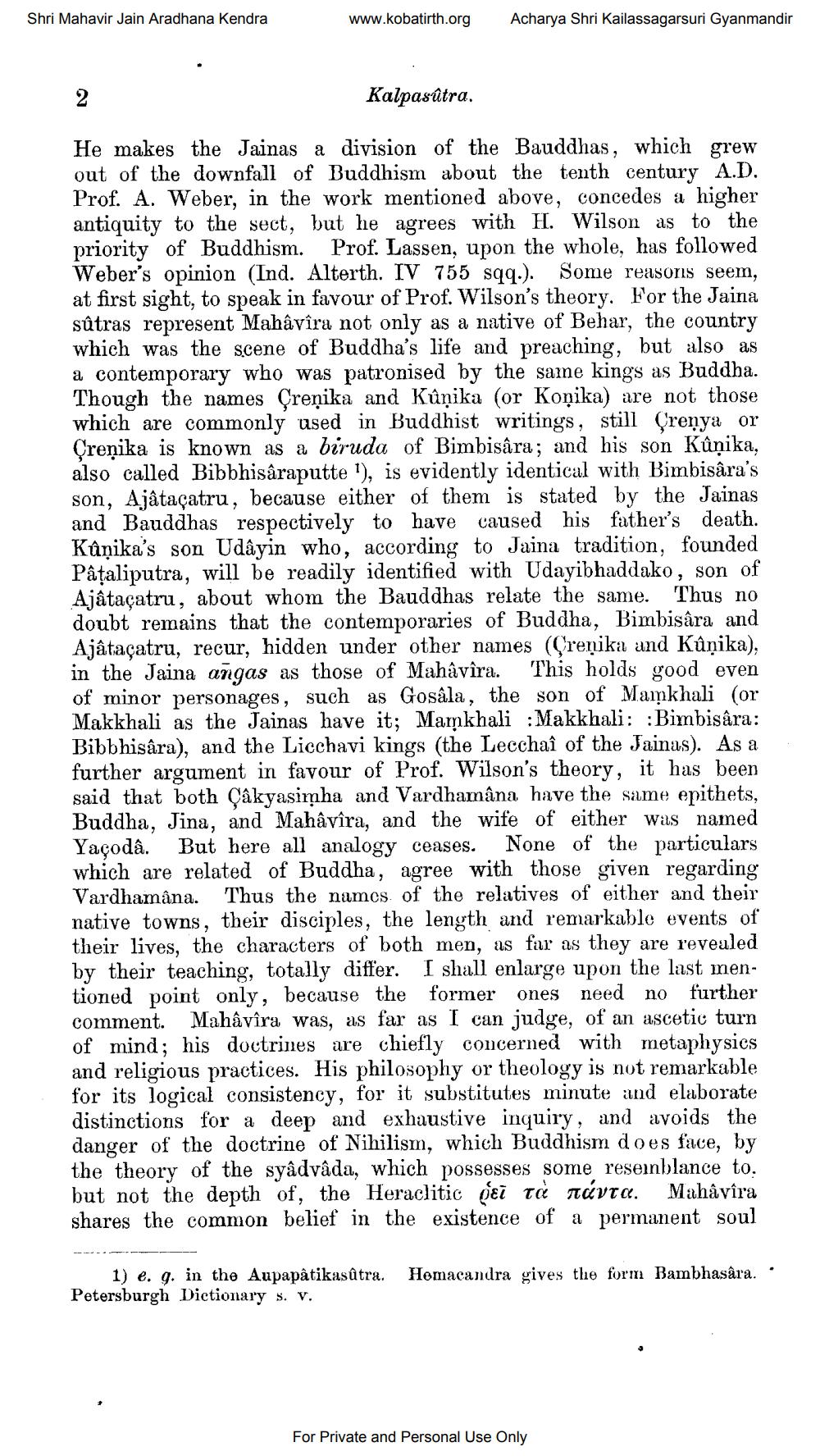________________
Shri Mahavir Jain Aradhana Kendra
www.kobatirth.org
Acharya Shri Kailassagarsuri Gyanmandir
Kalpasútra.
He makes the Jainas a division of the Bauddhas, which grew out of the downfall of Buddhism about the tenth century A.D. Prof. A. Weber, in the work mentioned above, concedes a higher antiquity to the sect, but he agrees with H. Wilson as to the priority of Buddhism. Prof. Lassen, upon the whole, has followed Weber's opinion (Ind. Alterth. IV 755 sqq.). Some reasons seem, at first sight, to speak in favour of Prof. Wilson's theory. For the Jaina sûtras represent Mahâvîra not only as a native of Behar, the country which was the scene of Buddha's life and preaching, but also as a contemporary who was patronised by the same kings as Buddha. Though the names Çreņika and Kûņika (or Konika) are not those which are commonly used in Buddhist writings, still Grenya or Çreņika is known as a biruda of Bimbisâra; and his son Kûņika, also called Bibbhisâraputte '), is evidently identical with Bimbisâra's son, Ajâtaçatru, because either of them is stated by the Jainas and Bauddhas respectively to have caused his father's death. Kûņika's son Udâyin who, according to Jaina tradition, founded Pâţaliputra, will be readily identified with Udayibhaddako, son of Ajátaçatru, about whom the Bauddhas relate the same. Thus no doubt remains that the contemporaries of Buddha, Bimbisâra and Ajâtaçatru, recur, hidden under other names (Creņika and Kûnika), in the Jaina angas as those of Mahâvîra. This holds good even of minor personages, such as Gosâla, the son of Mamkhali (or Makkhali as the Jainas have it; Mamkhali :Makkhali: :Bimbisâra: Bibbhisâra), and the Licchavi kings (the Lecchaî of the Jainas). As a further argument in favour of Prof. Wilson's theory, it has been said that both Çakyasimha and Vardhamâna have the same epithets, Buddha, Jina, and Mahâvîra, and the wife of either was named Yacoda. But here all analogy ceases. None of the particulars which are related of Buddha, agree with those given regarding Vardhamâna. Thus the names of the relatives of either and their native towns, their disciples, the length and remarkable events of their lives, the characters of both men, as far as they are revealed by their teaching, totally differ. I shall enlarge upon the last mentioned point only, because the former ones need no further comment. Mahâvîra was, as far as I can judge, of an ascetic turn of mind; his doctrines are chiefly concerned with metaphysics and religious practices. His philosophy or theology is not remarkable for its logical consistency, for it substitutes minute and elaborate distinctions for a deep and exhaustive inquiry, and avoids the danger of the doctrine of Nihilism, which Buddhism does face, by the theory of the syâdvâda, which possesses some reseinblance to. but not the depth of, the Heraclitic oai td núvra. Mahâvîra shares the common belief in the existence of a permanent soul
Hemacandra gives the form Bambhasara..
1) e. g. in the Aupapatikasûtra. Petersburgh Dictionary s. v.
For Private and Personal Use Only




